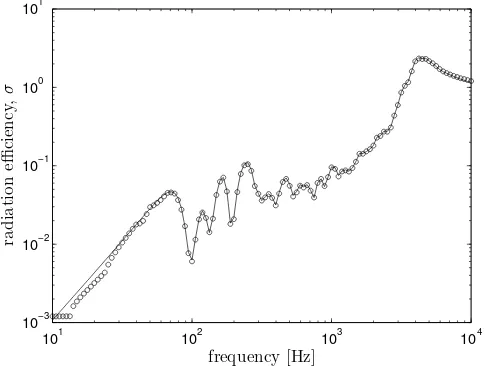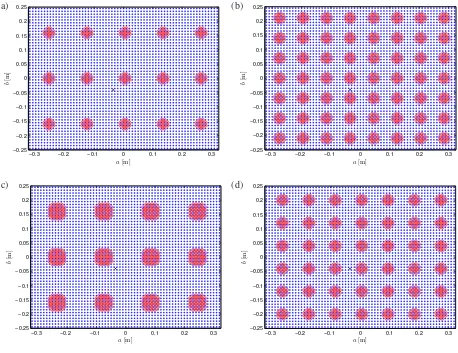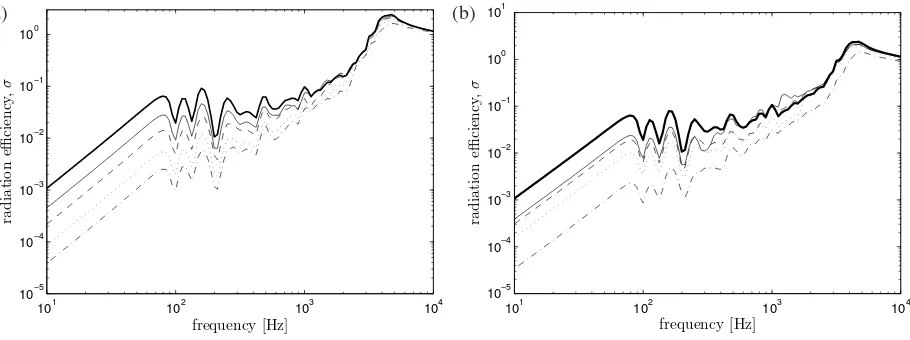MODELLED USING ELEMENTARY SOURCE
TECHNIQUE
Azma Putra, Noryani Muhammad and Nurain Shyafina
Faculty of Mechanical Engineering, Universiti Teknikal Malaysia Melaka, Hang Tuah Jaya 76100, Durian Tunggal, Melaka, Malaysia,
e-mail: [email protected]
David. J. Thompson
Institute of Sound and Vibration Research, University of Southampton, Highfield, Southampton SO17 1BJ, United Kingdom
A perforate is often used in practical engineering noise control to reduce sound radiation from a vibrating structure. This paper presents a prediction model to quantify this effect using el-ementary sources which can take account of the hole size and distribution across the plate surface. The model is based on discretization of the Rayleigh formula where a plate set in an infinite rigid baffle is divided into array of elementary source. A matrix of acoustic impedance as a function of acoustic pressure due to motion of the corresponding elementary source and other surrounding sources is assembled. The total sound power is determined from the sum-mation over the power contributions from all elementary sources. The results show that the radiation efficiency reduces as the perforation ratio is increased or the hole size is reduced.
1.
Introduction
Perforated plates are frequently found in applications where such structures are used for reduc-ing sound radiation, for examples the safety guard enclosures over flywheels or belt drives and the product collection hoppers. Such perforates are known to be capable of achieving considerable noise reduction. However, until recently, models to calculate their radiated sound are lacking.
Fahy and Thompson1 developed a model of radiation by plane bending waves propagating in an unbounded plate with uniform perforation which they used to calculate the radiation efficiency of a simply supported rectangular plate. It is assumed that the plate is effectively mounted in a similarly perforated rigid baffle, which limits its usefulness. Takahashi and Tanaka2 calculated the radiated power of a one-dimensional perforated panel with infinite length under a point force loading. Putra and Thompson3proposed a model to calculate the radiation efficiency of a perforated plate by extending Laulagnet’s model for radiation from unbaffled solid panel4 to include the impedance of a distribution of holes.
regard-ing the position of holes and the distance between holes. In this paper, an alternative approach is taken based on elementary sources. In principle, the concept is similar to the models of Vitielloet al.5 and Cunefare and Koopman6which used discrete elementary radiators to replace a continuous radiator. A continuous baffled source can be modelled by replacing it with an array of point monopole sources. In the same way, a perforated plate set in a rigid baffle can also be modelled by an array of sources, some representing the plate and others the holes.
2.
Governing equations
2.1 Discrete version of Rayleigh integral
The well-known Rayleigh integral7 can be used to calculate the sound pressure pat any point of observationxdue to a vibrating plate on the assumption that it is set in an infinite rigid baffle. The equation can be written as
p(x) = −2 time dependence of ejωt is assumed implicitly, where ω is the circular frequency and t is time. G is the free-field Green’s function, which is the sound pressure contribution at xdue to a unit point monopole source atx0. This equation can be written as
p(x) = jρck amplitude of the plate, ρ is the air density, c is the speed of sound and k = ω/c is the acoustic wavenumber.
The Rayleigh integral requires that the normal velocityvp is known over the whole plate surface area. For bending of a rectangular plate with dimensionsa×band assuming simply supported edges, the velocity can be written as the sum of modal contributions given by
vp(x0) =
whereumn is the complex velocity amplitude of mode (m,n). For a point force excitation at (xe, ye) and at frequencyω, it is given by8
where F is the force amplitude, η is the damping loss factor, M is the plate mass and ωmn is the natural frequency given by
ωmn = stiffness, in whichE is Young’s modulus andνis Poisson’s ratio. Note that the effect of perforation on the plate bending stiffness and mass has been neglected. Discretizing the Rayleigh integral, Eq. (2) can be re-written as
whereR = |x−xs|and xs is the centre of source positions. However for field positionsxon the surface (x = xr) the integrand is singular for r = s. To solve the integral for element r, another approximation corresponding to the pressure distribution on the plate surface is needed. Morse and Ingard9 give the total force per unit area (pressure) acting on a rectangular piston with small aspect ratio moving with uniform velocityUn. For a plate of dimensionsa×b, whereb ∼= a, the radiation impedance is given by
p
Applying this to the elemental source dS and assuming for simplicity a square piston, i.e. a =dx=
b =dy, this reduces to
Combining this with Eq.(6) the Rayleigh integral can be written in the form
p=MU (9)
whereMis an impedance matrix with elements
Mrs =
andpandUare vectors of pressure and velocity at each element.
2.2 Impedance matrix including perforation
Consider an array of holes on a plate, as shown in cross-section in Fig. 1. Each hole can be considered to be an acoustic source with volume velocityShUh whereUh is the average fluid velocity in the hole andShis the area of the hole. The pressure at any point on the plate surface can be written as a sum of the pressure contributions from all sources representing the plate and the holes according to Eq. (9). The matrixMcan be rearranged to give
M=
wherep−prefers to the pressure at plate locations due to plate sources,p−hrefers to the pressure at plate locations due to hole sources, etc. The pressure and velocity can similarly be partitioned into components corresponding to the plate and the holes giving
wherepp and Up are the acoustic pressure and velocity at the plate location, and ph and Uh are the same but for the hole location. The pressure at any point on the plate surface can be written as a sum of the pressure contributions from all sources representing the plate and the holes according to Eq. (9).
The matrixMcan be rearranged to give
do
Figure 1.Schematic view of analytical model of an array of discrete (monopole) sources for calculating the sound radiation of a perforated plate
wherep−prefers to the pressure at plate locations due to plate sources,p−hrefers to the pressure at plate locations due to hole sources, etc. The pressure and velocity can similarly be partitioned into components corresponding to the plate and the holes giving
wherepp and Up are the acoustic pressure and velocity at the plate location, and ph and Uh are the same but for the hole location.
2.3 Impedance of the holes and the acoustic power
It is assumed that the plate is located in an infinite baffle with a semi-infinite halfspace of fluid on both sides. The difference in the local pressure between the upper and lower ends of the hole drives the fluid through the hole (the pressure at the lower surface is−ph). These pressures, in turn, are modified by the fluid flow through the hole.
The sound power radiated by the plate can be expressed as the summation over the power contributions from all discrete elementary sources. Solving the above equations for Up, the sound power can thus be given by
W = 1
where∗indicates complex conjugate.
Finally, the total radiation efficiency of the perforated plate can be written as3
σ = W
ρcab(1−τ)Dv2 p
E (16)
whereτ is the perforation ratio andDv2 p
E
is the spatially-averaged mean square velocity across the total surface of the plate given by
D
Note that the inclusion of(1−τ)in Eq. (16) is to normalise the radiated power to the area of the plate. However, it is still assumed here that the bending stiffness of the panel is not affected by the perforation.
3.
Accuracy of the result
Firstly, the calculation is made for a solid plate to investigate the accuracy of the result with respect to number of discrete sources employed. The number of the sources is determined by the sample spacing dxand dy. The results are given for a rectangular aluminium plate having dimensions
101 102 103 104 10−3
10−2 10−1 100 101
frequency [Hz]
rad
iat
ion
effi
ci
en
cy
,
σ
Figure 2. Radiation efficiency of a baffled plate from discrete monopole sources for different grid sizes:· · ·
dx = 40mm,−−dx = 20mm,− · −dx = 15mm and — dx= 10mm (0.65×0.5×0.003 m aluminium
plate withη= 0.1).
loss factorη= 0.1. The point force is applied at (−0.13a,−0.1b) where the origin (0,0) is at the plate centre. The calculation is performed up to 10 kHz involving all modes withm≤25andn≤20.
The radiation efficiencies for different source spacings (with dx = dy) are shown in Fig. 2. As expected, the choice of dx affects the results at high frequency. For dx = 20mm, 15 mm and 10 mm, the curves collapse to one another up to roughly 6 kHz before they separate at higher fre-quencies. Among these spacings, there are actually small discrepancies below 6 kHz, but these can be considered negligible.
101 102 103 104
10−3 10−2 10−1 100 101
frequency [Hz]
ra
d
ia
ti
o
n
effi
ci
en
cy
,
σ
Figure 3. Comparison of radiation efficiency of a baffled plate from discrete monopole sources (—) with the FFT approach (◦)10(0.65×0.5×0.003m aluminium plate withη= 0.1).
4.
The effect of perforation
For the perforated plate, the position of the holes is chosen in relation to the array of the dis-crete sources. Figs. 4(a) and 4(b) respectively shows examples of the arrangement of holes for con-stant hole diameter of 40 mm with different hole numbers (different perforation ratiosτ) and conse-quently different hole spacings and for constant perforation ratio of 10% with different hole size to see the effect of hole density (number of holes per unit area). The point force excitation is located at (−0.054a,−0.08b).
The radiation efficiencies are plotted in Fig. 5. Figure 5(a) shows that the level reduces as the perforation ratio increases.3 This is because the counterflow of air through the holes reduces part of the volume sources on the plate surface in the vicinity of the holes, which then reduces the radiated sound. As for the perforated unbaffled plate case,3 the sound reduction due to perforation is constant in the fundamental mode region (< 50Hz). This effect reduces when the frequency approaches the critical frequency. The sound radiation can also be seen to be reduced by decreasing the hole size (i.e. increasing the hole density) as in Fig. 5(b).
In Fig. 5(b), with the smaller hole diameter of 15 mm, a reduction of 15 dB can be achieved at low frequencies with only 10% perforation ratio compared with the corresponding result in Fig. 5(a) with 31% perforation. Hence a high density of small holes is more effective than a low density of large holes.
Figure 4. Discrete sources on a rectangular plate (0.65×0.5m) with arrangement of holes for constant
hole diameterdo = 40mm and different perforation ratios: (a)τ = 6%,lx = 130mm,ly = 160; (b)τ = 22%,
101 102 103 104 10−5
10−4 10−3 10−2 10−1 100
frequency [Hz]
ra
d
ia
ti
o
n
effi
ci
en
cy
,
σ
(a)
101 102 103 104
10−5 10−4 10−3 10−2 10−1 100 101
frequency [Hz]
ra
d
ia
ti
o
n
effi
ci
en
cy
,
σ
(b)
Figure 5. Radiation efficiency of a perforated baffled plate (0.65×0.5×0.003m,η = 0.1) from discrete monopole sources for (a) constant hole diameterdo= 40mm:
—τ = 6%,−−τ = 12%,· · ·τ = 22%,− · −τ = 31% and (b) constant perforation ratioτ = 10%: —do= 83
mm,−−do= 59mm,· · ·do= 32mm,− · −do = 15mm (—(thick) unperforated).
5.
Conclusions
A model of sound radiation from a perforated baffled plate has been proposed which is devel-oped by dividing the plate and the holes into elementary monopole sources. The contribution of the sources and their influence on each other is assembled into an impedance matrix. It is found that the radiation efficiency reduces as the perforation ratio is increased or the hole size is reduced, consistent with earlier results.
The proposed model avoids the assumption of a continuous layer of impedance as the inter-action of the holes with the sound field is analysed individually and the holes are now arranged at a known separation distance. It is therefore of interested to further investigate the effect of hole distance particularly on the frequency limit of sound reduction.
6.
Acknowledgment
Part of this work is supported by the Short Term Research Grant under Universiti Teknikal Malaysia Melaka No. PJP/2012/FKM(5C)/S01007.
REFERENCES
1 F. J. Fahy and D. J. Thompson, The effect of perforation on the radiation efficiency of vibrating plates,Proceedings of the Institute of Acoustics, 26(2004).
2 D. Takahashi and M. Tanaka, Flexural vibration of perforated plates and porous elastic materials under acoustic loading,Journal of the Acoustical Society of America,112, 1456–1464, (2002).
3 A. Putra and D. J. Thompson, Sound radiation from perforated plates,Journal of Sound and Vi-bration,329, 4227–4250, (2010)
5 P. Vitiello, P. A. Nelson and M. Petyt, Numerical studies of the active control of sound transmission through double partitions, ISVR Technical Report 183, University of Southampton (1989).
6 K. A. Cunefare and G. H. Koopmann, Global optimum active noise control: surface and far field effects,Journal of Acoustical Society of America,90, 365–373, (1991)
7 L. Rayleigh.The Theory of Sound, 2nd Ed., (1896).
8 L. Cremer, M. Heckl and B. A. T. Petersson.Structure-Borne Sound: Structural Vibrations and Sound Radiation at Audio Frequencies, Springer, Berlin, 3rd Ed., (2005).
9 P. M. Morse and U. Ingard.Theoretical Acoustics, McGraw-Hill, New York, (1968).



